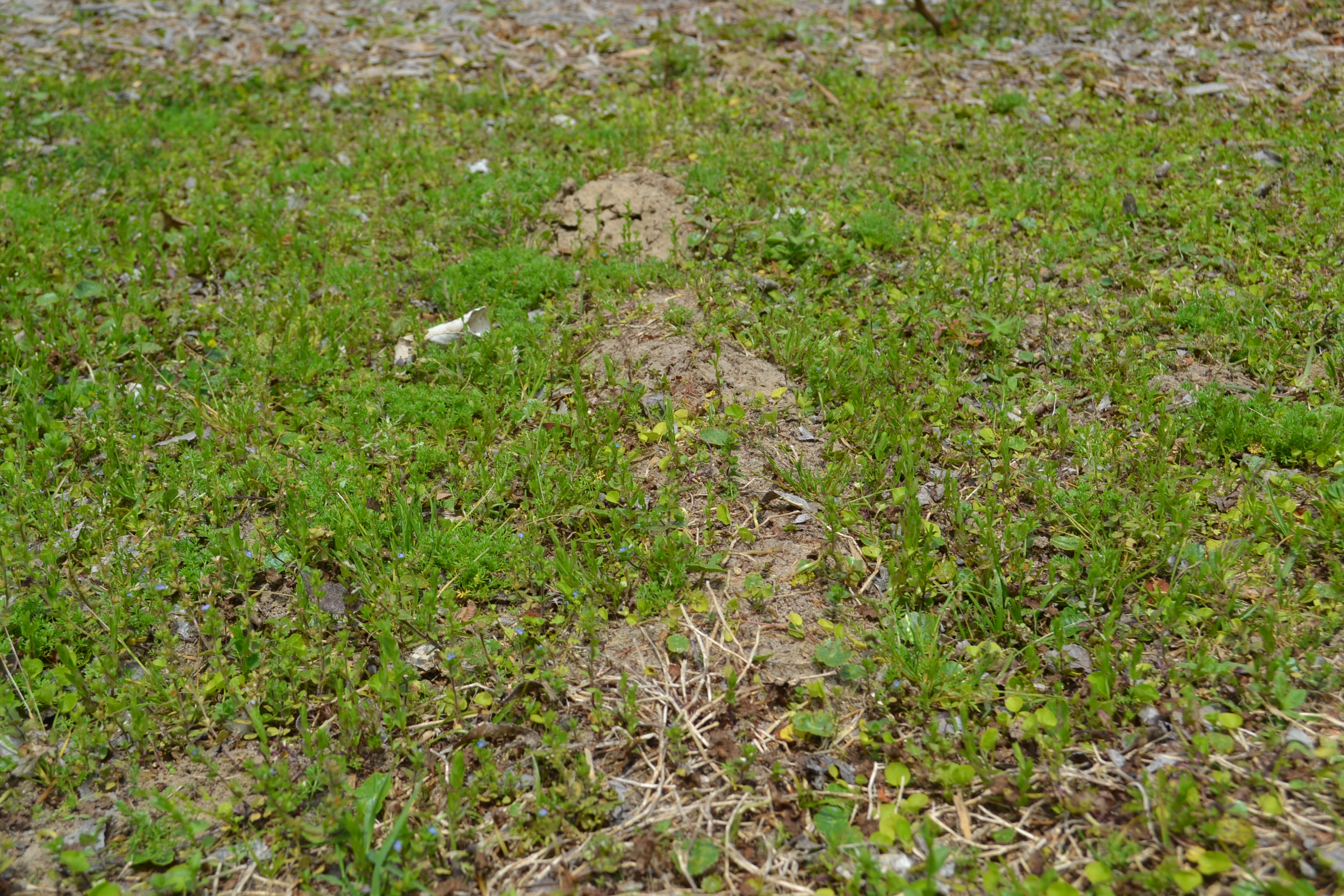
by Beth Bolles | Apr 15, 2014
How can an animal that does such much to help rid your lawn of pests be so hated by most homeowners? Such is the life of the mole.
The beneficial mammal is a soil dweller that tunnels through the soil, increasing aeration as it searches out a meal of beetle grubs, mole crickets, and slugs. Moles prefer loose soil and can tunnel more than 15 feet an hour. Moist soil brings the food source closer to the surface which in turn bring moles up to expose raised tunnels to homeowners. These tunnels are mostly cosmetic and show up easily in mulched areas and lawns with heavier weed populations. Most homeowners with a healthy, thicker lawn will rarely notice mole activity unless they encounter loose areas as they walk over the turf. These can easily be pressed back down with your foot.
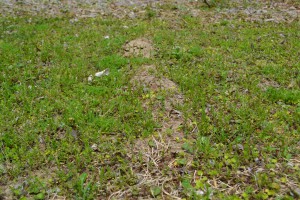
Mole tunnel in weedy area. Photo: Beth Bolles, UF IFAS Extension Escambia County
There are management techniques for moles which include traps and ridding the lawn of the food source. The best practices are to manage the turf through proper mowing, watering, and fertilizing to create a uniform, healthy cover. For the most part, mole management is not even required. Consider the benefits of the moles as predators and allow them to be a natural part of the landscape environment. For more information on moles read the University of Florida IFAS Extension publication.
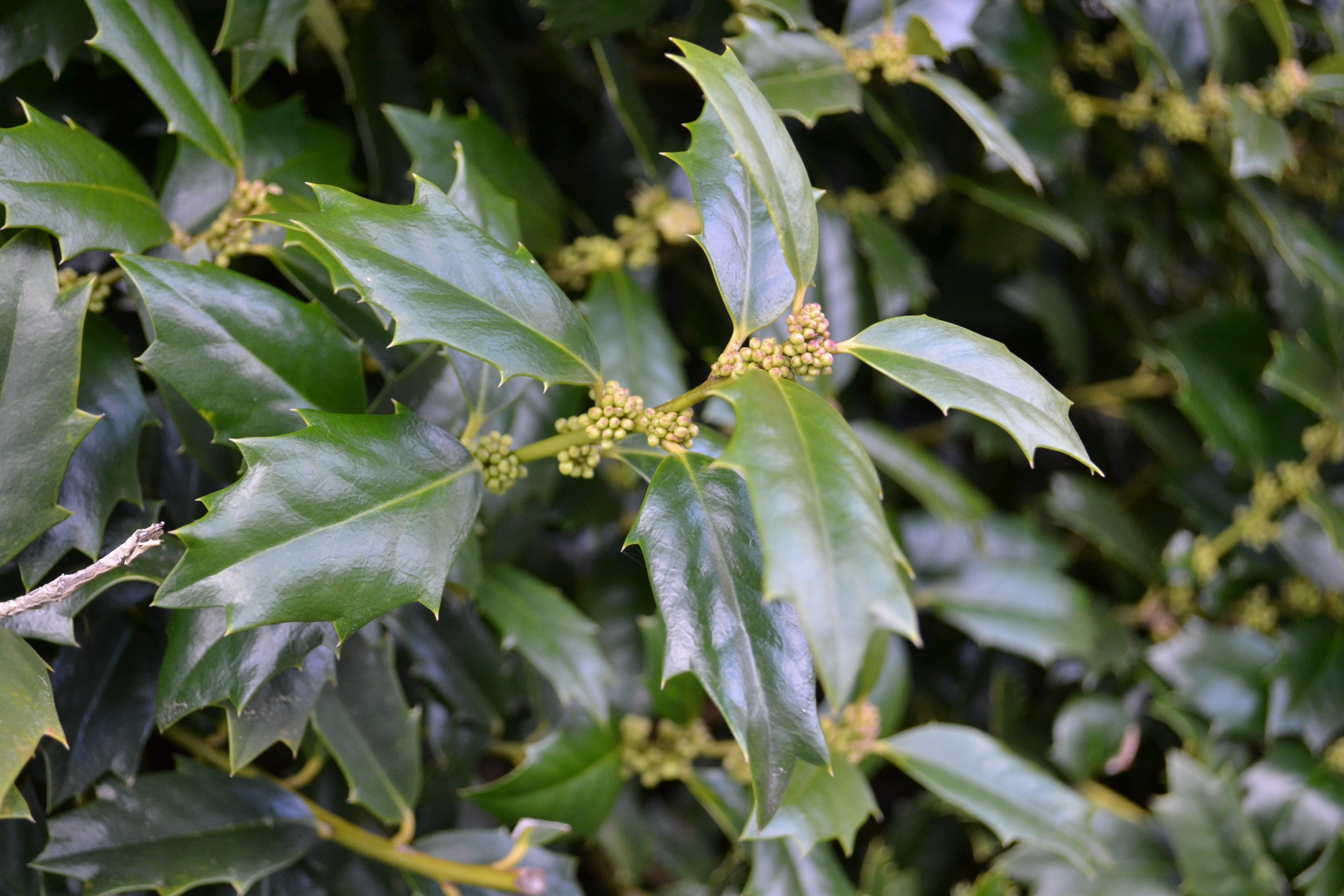
by Beth Bolles | Mar 12, 2014
Landscapes will soon be transitioning from the dormant phase to actively growing and one of the most beneficial insects of all will be back in action. As soon as flowers open, bees will be visiting to gather pollen and nectar.
This year be a little more observant in the landscape and at your local nursery so that you protect bees during your yard activities. Several insecticides will have new labels that indicate a toxicity to bees and restrictions about applications to blooming plants. Since many landscapes have a wide variety of blooming plants, be very careful not to inadvertently spray when bees are visiting open flowers. Bees are not only killed by a direct spray of certain insecticides, but may carry residual pesticides back to the colony in pollen and nectar.
Since bees and other pollinators are so vital to our food production system, all people who work in landscapes or enjoy gardening as a hobby, need to be a part of bee protection. Read labels, only spray when absolutely necessary, and learn that a little cosmetic damage is worth it in order to protect pollinators.
Some selections of hollies are one of the first landscape shrubs visited by bees in the winter. Learn about the other plants in your yard that are visited by bees so you are better able to protect them.
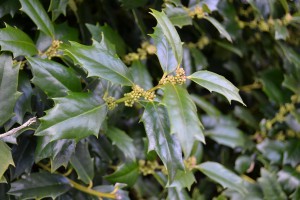
Holly flowers will soon open.
Photo: Beth Bolles, UF IFAS Escambia County Extension
by Les Harrison | Mar 4, 2014

An assortment of Heirloom Tomatoes. Image Credit Dan Culbert
Thursday night’s temperatures have confirmed the winter of 2014 is not over. This year’s cold days and freezing nights have taken a toll on power bills, auto batteries, and the mosquitoes.
Still there is indication that spring will soon be coming. The most tangible evidence is arriving in north Florida mailboxes almost daily.
Garden catalogs from every part of the nation are finding their way into many area homes. Their pages promise the buyer the potential for legendary success and the envy of their friends and neighbors.
After all, who can resist the full color beauty of giant flowers, large luscious fruit and vegetables which are sure to win a prize at the fair? There is not a runt, reject or cull in all the pages of these publications offering the mortal version of horticultural heaven.
Before ordering, the would-be gardener should consider several factors to increase the likelihood of a positive gardening experience. A failure will waste not only funds, but also much time and hard work and may introduce a long-term problem or two.
Cultivar selection for a tree, shrub, vegetable or fruit is critically important to producing the desired results. While a specific plant cultivar may grow and produce in one environment, it may not do so in all situations.
A common example of this problem is grape vines offered. Only muscadine grapes will grow and produce locally because Pierce’s disease kills other varieties.
Carefully examine the growing zones recommended by the catalog for specific cultivars. Check with fellow gardeners and the UF/IFAS Extension Office to see if they have any information or experience with any cultivars under consideration.
Heirloom varieties are especially sensitive to the variances in growing conditions. While they offer unusual and sometimes unique taste and culinary traits or landscaping characteristics, these antique varieties can be a challenge to grow.
Their genetic potential can make a consistent yield, especially for the novice growers, a real effort. Also, as an open pollinator variety, the results can be inconsistent.
Another question for the catalog company customer is new or untried plants varieties. Some of these plants are patented and few or no trials have been performed with them in north Florida’s growing zone.
Caution should be used when ordering these seed or plants. Being the first in North Florida to cultivate a new variety may require a large commitment of time and resources, and may produce only a large disappointment.
Check with fellow gardeners, local nurseries and your UF/IFAS Extension Office for available information on these new or patented varieties. It may save much wasted motion.
Lastly, be sure the plant or seeds under consideration do not have the potential as exotic invasive pests. As hard as this may be to believe, this does occur.
Some catalog vendors will advise buyers in the ordering instructions or at the time of ordering. Either way, the purchaser should check to verify the plant ordered does not have the potential to escape control and damage the environment.
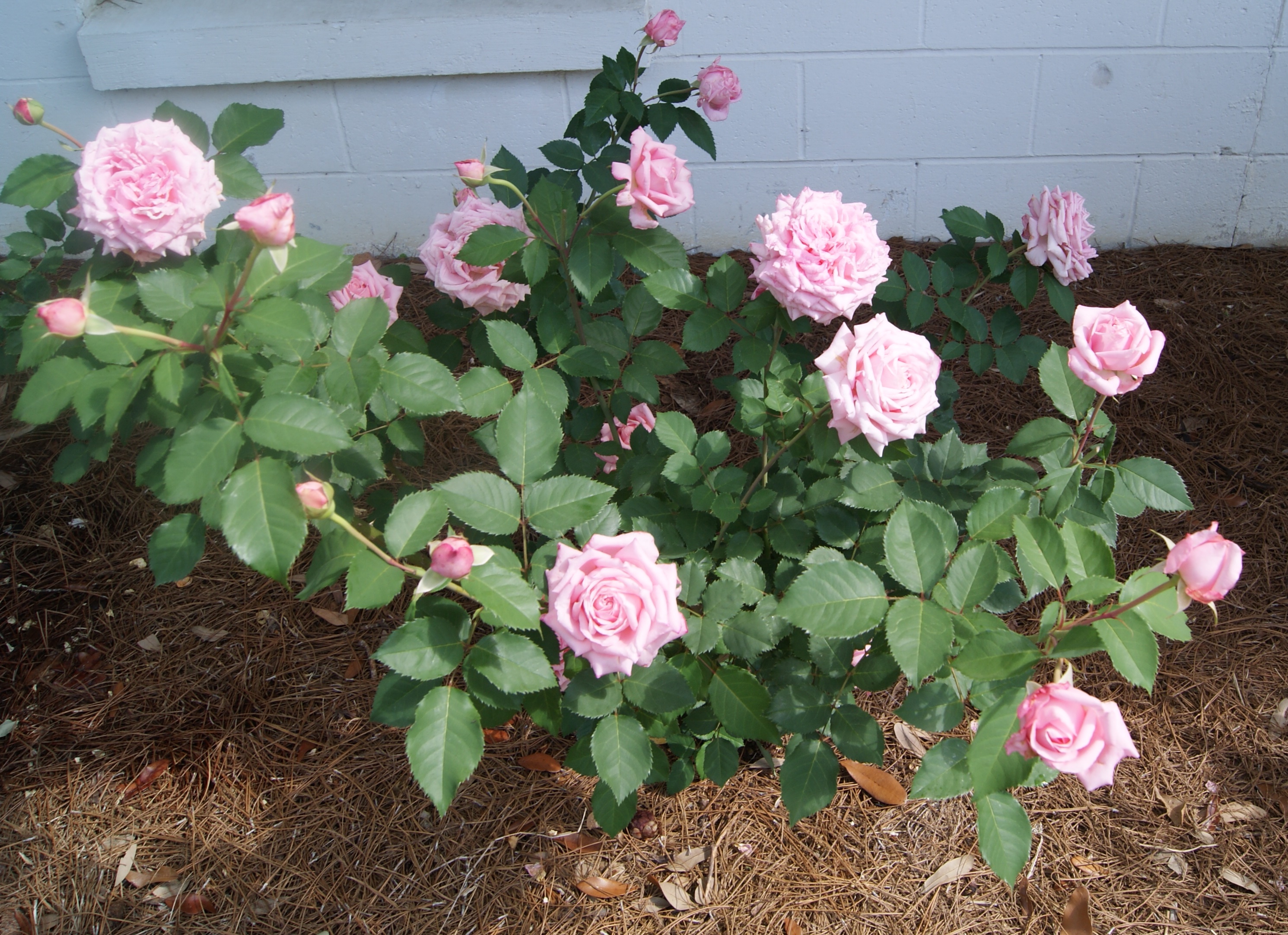
by Taylor Vandiver | Feb 25, 2014
Considering it is the month of Valentine’s, roses are an appropriate subject to discuss. Not bouquets couriered to various locations all over town, but bushes in the landscape that have been strategically neglected over the winter. Now their time has come; pull on the gloves and get to work.
February is the perfect time to prune rose bushes. Pruning is a step that is required to maintain healthy roses. When roses are pruned, new growth is promoted by removing dead, broken or diseased canes. Pruning also allows the gardener to give their plant an attractive shape and encourage flowering, which is ultimately the reason roses are planted!
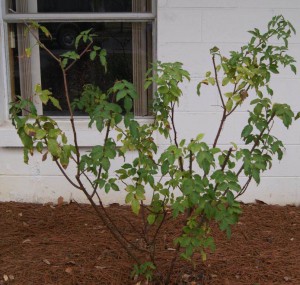
Belinda’s Dream rose before pruning. Image Credit Matthew Orwat
Deciding which roses to prune will depend on their class. Hybrid tea, grandiflora and floribunda roses are repeat bloomers and need a moderate to heavy annual pruning this time of year. Some old-fashioned roses and climbers that bloom only once a year should be treated differently and pruned immediately after flowering. They set their buds on old wood from the previous year’s growth; therefore, pruning them would remove most of this year’s blooms. An exception to this would be dead, diseased or damaged wood on any rose bush or canes that are crossing and rubbing. This should be removed immediately upon notice.
There are certain techniques that should be used when pruning any type of rose, no matter the time of year. Any pruning shear, saw or lopper you use should be sharp and sterile. Always wear protective gloves when dealing with roses, unless you don’t mind coming back bloody and mangled.
[warning]
Crown gall and canker can be spread between gardens and individual plants by dirty shears. To prevent the spread of disease, always disinfect pruning shears when beginning to prune with a 5-10% bleach or 20% rubbing alcohol solution, especiallly if they have been used in any other garden. If crown gall or canker has been found in one’s own garden, shears should be disinfected between each plant, no exception. This should also occur when bringing new plants into the garden, until they have been observed to be disease free.
[/warning]
The first step when pruning any rose is to remove dead, damaged or weak stems leaving only the most vigorous, healthy canes. Try to cut the stems one inch below darkened areas, making sure to cut back to green wood. Always make your cut at a 45-degree angle; this will keep water from sitting on top of a stem and causing rot. When pruning try to open up the center of the rose bush. Pruning like this will increase air circulation and help prevent diseases.
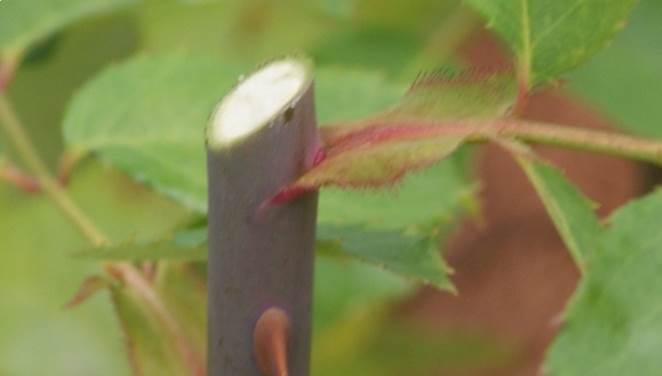
Pruning Cut on Belinda’s Dream rose. Image Credit Matthew Orwat
Since roses send out new growth from the bud just below a pruning cut, try to make pruning cuts above a leaf bud facing out from the center of the plant. Make your cut about ¼ inch above the bud and at the same angle as the bud. If any rubbing or crossing branches are noticed, the weakest of those branches should be removed.
Deadheading, or removing spent flowers, can also be done at this time of year. When deadheading, remove the flower by making a cut just above the next five or seven-leaf branch down on the stem. This will allow for a strong and healthy cane to grow in its place. If no live buds remain, remove the entire cane.
Modern reblooming roses (hybrid teas, floribundas, and grandifloras) should be pruned just as the buds begin to swell, which is around mid to late February. When practicing hard pruning, try to leave about four to eight large, healthy canes the diameter of your finger or larger on the shrub. For a more moderate approach, prune shrubs as discussed earlier and cut them back to about 12 to 24 inches from ground level. Generally, any cane thinner than a pencil should be removed.
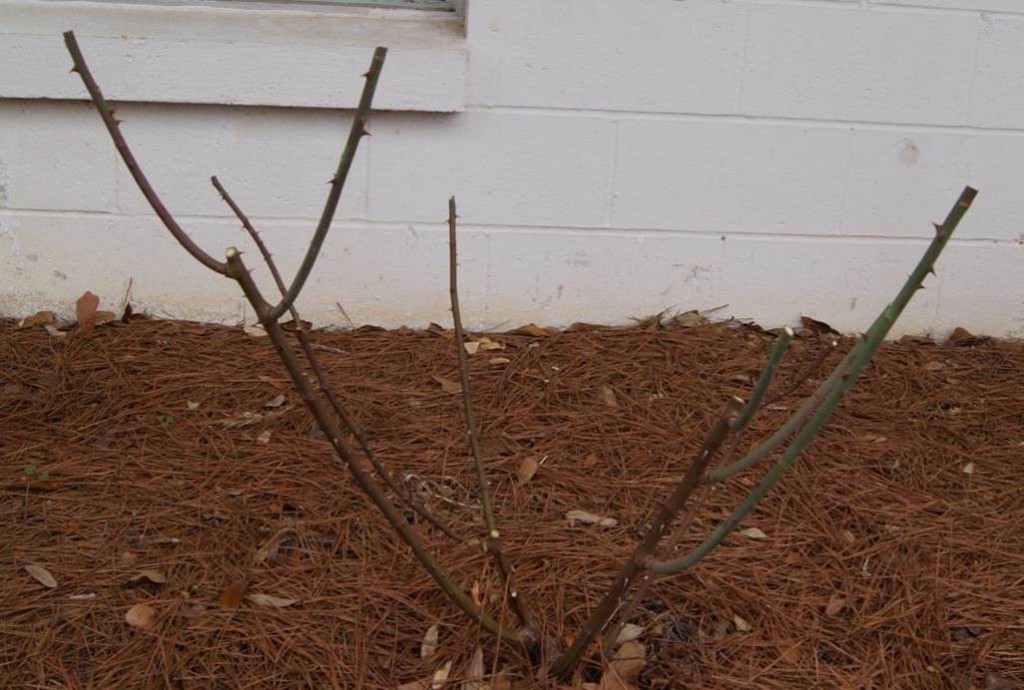
Belinda’s Dream rose after pruning. Image Credit Matthew Orwat
Don’t worry about pruning recently purchased new roses. Newly purchased roses have most likely been pruned, and no further cutting is necessary. Hopefully with the help of this article you can make a date to spend some quality time with your roses this season. The price of neglect is overgrown roses that are not nearly as attractive.

First flush of properly pruned Belinda’s Dream shrub rose. Image credit Matthew Orwat
Article written by Taylor Vandiver with additional content about sanitation by Matthew Orwat

by Taylor Vandiver | Feb 25, 2014
So you have alkaline soil… What next?
Throughout the Panhandle, a common problem that often arises is finding a way to raise soil pH. This is due to the fact that we often encounter sandy, acid soils in this region. An often overlooked issue is explaining the process of gardening in a soil that tends to be more alkaline in nature.
Soil pH is measured using a scale from 0 to 14. On this scale, a value of 7 is neutral, pH values less than 7 are acidic, and pH values greater than 7 are alkaline. Soil pH directly affects the growth and quality of many landscape plants. Extreme pH levels can prevent certain nutrients from being available to plants. Therefore, a high pH may make it difficult to grow certain plants.
Often alkaline soils occur in the home landscape as a result of calcium carbonate-rich building materials (i.e., concrete, stucco, etc.) that may have been left in the soil following construction. Soils that contain limestone, marl or seashells are also usually alkaline in nature. There are a few measures that can be taken in order to combat high pH. Incorporating soil amendments containing organic material is the most common method implemented to reverse alkalinity. Peat or sphagnum peat moss is generally acidic and will lower pH better than other organic materials. Adding elemental sulfur is another common practice. A soil test will need to be performed often in order to add the correct amount of sulfur to reach an optimal pH level.
Lowering the pH of strongly alkaline soils is much more difficult than raising it. Unfortunately, there is no way to permanently lower the pH of soils severely impacted by alkaline construction materials. In these circumstances, it may be best to select plants that are tolerant of high pH conditions to avoid chronic plant nutrition problems.
Some plants that will tolerate alkaline soils:
-
Shrubs
- Glossy Abelia (Abelia Xgrandiflora)
- Sweet Shrub (Calycanthus floridus)
- Flowering Quince (Chaenomeles speciosa)
- Burford Holly (Ilex cornuta ‘Burfordii’)
- Indian Hawthorne (Rhaphiolepis indica)

Firebush is wonderful butterfly attractant. Photo courtesy of UF/IFAS.
-
Perennials
- Larkspur (Delphinium carolinianum)
- Pinks (Dianthus spp.)
- Firebush (Hamelia patens)
- Plumbago (Plumbago ariculata)

Zinnias come in a variety of colors, shapes and sizes. Photo courtesy of UF/IFAS.
-
Annuals
- California Poppy (Eschscholzia californica)
- Zinnias (Zinnia spp.)
- Cosmos (Cosmos bipinnatus)

by Julie McConnell | Feb 18, 2014

Lichen on trunk of oak tree. Image: Julie McConnell, UF/IFAS
Spanish moss and lichen have earned an inaccurate reputation for damaging trees and shrubs in the Florida landscape. Although they may be found in plants that are in decline or showing stress symptoms, they are simply taking advantage of space available to survive. Both plants are epiphytes and are obtaining moisture and nutrients from the atmosphere rather than from the plants they rest upon.

Spanish moss. Image: Julie McConnell, UF/IFAS
Lichen are more commonly found on plants that are in poor health because they need a plant that is growing slowly and access to sunlight. These conditions can typically be found in thin canopies of trees and shrubs under stress. Although they are firmly attached to the surface of the plant, they are not taking nutrients from the tree or shrub, but rather from the air and other sources such as organic debris and bird excrement. If you find lichen on your landscape plants, look further into what stress factors might be causing the plant to grow slowly such as compacted soil, extreme weather conditions, drought stress, disease or insect pressure.
Spanish moss does not harm trees and many people find it an appealing asset to their landscapes. Common misconceptions about Spanish moss include that the weight causes branches to break and that it is a host site for chiggers. Spanish moss is very light and any additional weight is typically insignificant. Although it may harbor some insects and provide nesting material for birds and other wildlife, Spanish moss in trees is not a site conducive to chiggers because they favor low-lying moist environments.
To read more about Spanish moss, lichens, and other common epiphytes please read the EDIS publication “Spanish Moss, Ball Moss, and Lichens – Harmless Epiphytes.”
















